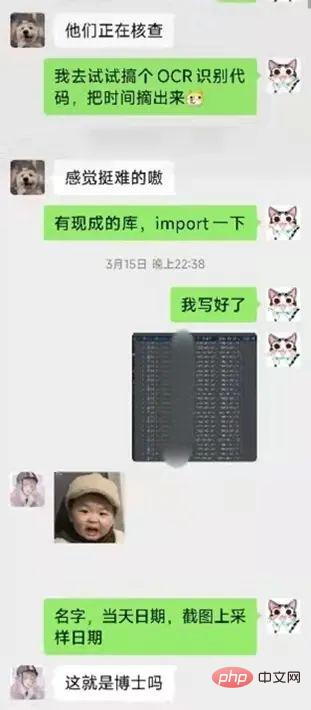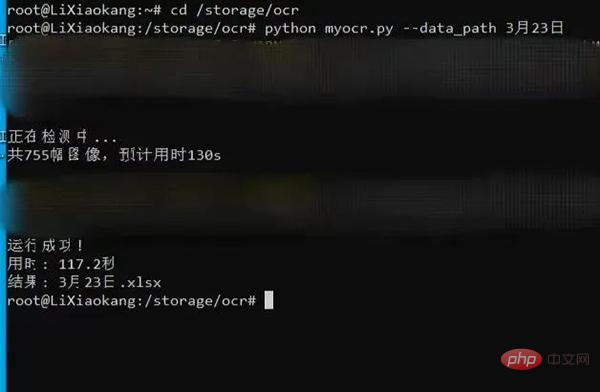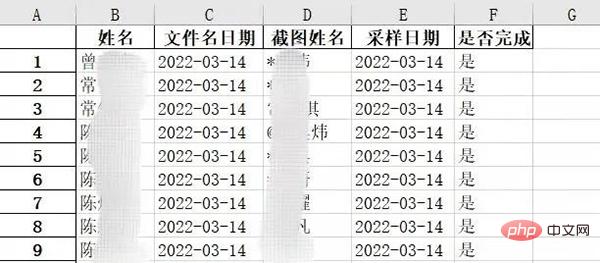 Backend Development
Backend Development
 Python Tutorial
Python Tutorial
 130 lines of Python code to complete nucleic acid statistics, solving one hour of manual work in two minutes!
130 lines of Python code to complete nucleic acid statistics, solving one hour of manual work in two minutes!
130 lines of Python code to complete nucleic acid statistics, solving one hour of manual work in two minutes!

During this period, the development of the epidemic across the country has affected people's hearts. In order to better cooperate with epidemic prevention and control, Fudan University has launched regular nucleic acid screening since early March.
This job requires counselors to check the screenshots of students' "Health Cloud" nucleic acid completion one by one to ensure that "no one is missed." It sounds simple but is difficult to do. Faced with dozens or even hundreds of highly repetitive screenshots, manual verification is often time-consuming and labor-intensive, and mistakes may be made accidentally.
In order to solve this problem, Li Xiaokang, a doctoral student in the School of Information Science and Engineering, wrote 130 lines of code and quickly developed a small program.
This small program has greatly improved the speed and accuracy of nucleic acid verification. It took several people to check 800 screenshots for more than an hour, but now it only takes 2 minutes to get the results.




 ##Excel file output by the program (Source: Fudan University official account)
##Excel file output by the program (Source: Fudan University official account)
Apply what you learn and actively fight the epidemic
Talk about The original intention of developing the program, Li Xiaokang said that he just wanted to reduce the workload of himself and the teachers around him. Because the program is written in Python and the code comments are complete, those who know how to use Python can get started quickly.
At the same time, in order to facilitate the use of teachers who cannot program, Li Xiaokang also encapsulated the program so that it can be run by simply entering a line of code.
In Li Xiaokang’s original words: “Although the principle is very simple, anyone who can write code will understand what is going on at the first time, but if you don’t do related work, you won’t feel it. Since the matter is time-consuming and labor-intensive, I will naturally not come up with a solution. I just use the knowledge I have learned to solve the difficulties in practical work."
Fudan University officials revealed that the school information office has contacted Li Xiaokang. New mini programs are being developed based on demand. It is expected that in the near future, teachers and students will no longer have to manually collect nucleic acid screenshots. They can simply upload pictures directly through the mini program to view statistical results.
The above is the detailed content of 130 lines of Python code to complete nucleic acid statistics, solving one hour of manual work in two minutes!. For more information, please follow other related articles on the PHP Chinese website!

Hot AI Tools

Undresser.AI Undress
AI-powered app for creating realistic nude photos

AI Clothes Remover
Online AI tool for removing clothes from photos.

Undress AI Tool
Undress images for free

Clothoff.io
AI clothes remover

Video Face Swap
Swap faces in any video effortlessly with our completely free AI face swap tool!

Hot Article

Hot Tools

Notepad++7.3.1
Easy-to-use and free code editor

SublimeText3 Chinese version
Chinese version, very easy to use

Zend Studio 13.0.1
Powerful PHP integrated development environment

Dreamweaver CS6
Visual web development tools

SublimeText3 Mac version
God-level code editing software (SublimeText3)

Hot Topics
 PHP and Python: Different Paradigms Explained
Apr 18, 2025 am 12:26 AM
PHP and Python: Different Paradigms Explained
Apr 18, 2025 am 12:26 AM
PHP is mainly procedural programming, but also supports object-oriented programming (OOP); Python supports a variety of paradigms, including OOP, functional and procedural programming. PHP is suitable for web development, and Python is suitable for a variety of applications such as data analysis and machine learning.
 Choosing Between PHP and Python: A Guide
Apr 18, 2025 am 12:24 AM
Choosing Between PHP and Python: A Guide
Apr 18, 2025 am 12:24 AM
PHP is suitable for web development and rapid prototyping, and Python is suitable for data science and machine learning. 1.PHP is used for dynamic web development, with simple syntax and suitable for rapid development. 2. Python has concise syntax, is suitable for multiple fields, and has a strong library ecosystem.
 PHP and Python: A Deep Dive into Their History
Apr 18, 2025 am 12:25 AM
PHP and Python: A Deep Dive into Their History
Apr 18, 2025 am 12:25 AM
PHP originated in 1994 and was developed by RasmusLerdorf. It was originally used to track website visitors and gradually evolved into a server-side scripting language and was widely used in web development. Python was developed by Guidovan Rossum in the late 1980s and was first released in 1991. It emphasizes code readability and simplicity, and is suitable for scientific computing, data analysis and other fields.
 Python vs. JavaScript: The Learning Curve and Ease of Use
Apr 16, 2025 am 12:12 AM
Python vs. JavaScript: The Learning Curve and Ease of Use
Apr 16, 2025 am 12:12 AM
Python is more suitable for beginners, with a smooth learning curve and concise syntax; JavaScript is suitable for front-end development, with a steep learning curve and flexible syntax. 1. Python syntax is intuitive and suitable for data science and back-end development. 2. JavaScript is flexible and widely used in front-end and server-side programming.
 Can vs code run in Windows 8
Apr 15, 2025 pm 07:24 PM
Can vs code run in Windows 8
Apr 15, 2025 pm 07:24 PM
VS Code can run on Windows 8, but the experience may not be great. First make sure the system has been updated to the latest patch, then download the VS Code installation package that matches the system architecture and install it as prompted. After installation, be aware that some extensions may be incompatible with Windows 8 and need to look for alternative extensions or use newer Windows systems in a virtual machine. Install the necessary extensions to check whether they work properly. Although VS Code is feasible on Windows 8, it is recommended to upgrade to a newer Windows system for a better development experience and security.
 How to run sublime code python
Apr 16, 2025 am 08:48 AM
How to run sublime code python
Apr 16, 2025 am 08:48 AM
To run Python code in Sublime Text, you need to install the Python plug-in first, then create a .py file and write the code, and finally press Ctrl B to run the code, and the output will be displayed in the console.
 Where to write code in vscode
Apr 15, 2025 pm 09:54 PM
Where to write code in vscode
Apr 15, 2025 pm 09:54 PM
Writing code in Visual Studio Code (VSCode) is simple and easy to use. Just install VSCode, create a project, select a language, create a file, write code, save and run it. The advantages of VSCode include cross-platform, free and open source, powerful features, rich extensions, and lightweight and fast.
 Can visual studio code be used in python
Apr 15, 2025 pm 08:18 PM
Can visual studio code be used in python
Apr 15, 2025 pm 08:18 PM
VS Code can be used to write Python and provides many features that make it an ideal tool for developing Python applications. It allows users to: install Python extensions to get functions such as code completion, syntax highlighting, and debugging. Use the debugger to track code step by step, find and fix errors. Integrate Git for version control. Use code formatting tools to maintain code consistency. Use the Linting tool to spot potential problems ahead of time.





